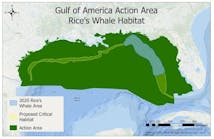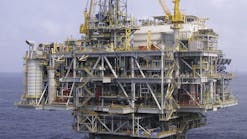Donald J. Weintritt, Nida S. Qaisieh
Weintritt Consulting Services
Lafayette, La.
Gordon H. Otto
University of Houston
Houston
An operator can improve the precision of the Environmental Protection Agency (EPA) static sheen test for wastes discharged offshore by learning the characteristics of sheen, improving observer judgment through training, and eliminating conventional practices that adversely affect the perception of sheen.
Incorrectly judging the sheen as too large may increase drilling costs if discharge must be halted and the fluids shipped to shore for disposal. Conversely, incorrectly judging the sheen as too small could result in large fines or other penalties.
The main benefit for field personnel to develop expert sheen test techniques is the ability to make the difficult choice of continuing legal offshore discharge or sending material to shore for disposal.
The EPA National Pollution Discharge Elimination System general permit No. GMG290000 requires offshore operators to conduct a static sheen test during discharge of production or drilling wastes. The static sheen test is sensitive to oil at low concentrations and is subject to errors in interpretation.
The details of the static sheen test are published in Federal Register Vol. 57, No. 224, Nov. 19, 1992, pp. 54652 54657. Table 1 lists the major discharges covered by the document.
When atmospheric and surface conditions permit, the visual sheen test (watching the open water near the discharge point) is acceptable. If fog, darkness, rough seas, or other conditions prevent the observer from detecting a sheen, then the protocol specifies a static sheen test to determine if the materials discharged contain "free oil."
(Free oil refers to any oil in a waste stream that produces a sheen covering 50% or more of the surface of a pan with a surface area of 1,000 sq cm.)
The static sheen test is typically conducted on a bench top under fluorescent or other adequate lighting. Although the test is simple to perform, it is imprecise and subject to bias unless several measures are taken to reduce errors such as a lack of consistency or site-specific testing problems.
STATIC SHEEN TEST
Table 2 outlines the new static sheen test for the Gulf of Mexico. In the test, a 15 ml aliquot of a 200-500 ml representative sample of drilling mud or well-treatment fluid is injected slightly below the surface of the water. The purpose of the test is to determine if 50% or more of the surface of the pan is covered by a floating film of oil at any time up to 1 hr after the start of the test.
If the area covered by the oil is less than 50%, then by definition there is no free oil, and discharge of waste fluids can continue.
Drill cuttings or produced sand follow a similar protocol except that a 15 g solids sample is weighed in a small dish. The edge of the dish is held below the surface of the water, and the contents are pushed into the water with a spatula. Following the addition of a liquid or solids sample to the water, the mixture must be agitated with a syringe or spatula.
Fig. 1 is an example of an oily sheen from production waste that appears to cover more than 50% of the surface of the test pan. The perception of a high percentage of surface sheen for this sample results from the combination of free oil and floating hydrophobic fine solids that spontaneously dispersed across the surface of the water.
All sheen tests are subjective, whether based on a visual sighting across a quarter mile of open water or an 11 x 13 in. pan. The accuracy of the subjective sheen test cannot be established because there are no standards or methods of calibration.
Ordinarily, the lack of accuracy would be a matter of no great concern. New EPA rules, however, carry many different penalties-criminal, civil, and administrative. Clearly, a failure to judge correctly whether the discharged wastes have a sheen because of free oil could result in a fine and a citation for the individual and the company.
The EPA requirement that the observer use his personal judgment and be liable for the outcome adds additional stress to the job not present with other environmental test methods. Thus, industry personnel responsible for authorizing discharge based on the EPA static sheen test tend to be very conservative in applying their judgment.
For example, uncertainty over whether the surface of the test pan has 50% or more sheen can be the sole reason for an operator sending an entire mud system to shore for disposal while a costly new mud system is displaced into the hole. The cost of such a decision can be high, up to $1 million depending on the complexity and volume of mud.
BACKGROUND
Many people believe an oily sheen is one of the first signs of pollution. In 1970, the U.S. secretary of the interior defined a harmful quantity of oil as that amount which causes a sheen or discoloration on the surface of water. This definition has since been a part of the EPA regulations.
The laboratory-type sheen test was first used in Alaska where ice flows precluded use of the visual sheen test. Since then different EPA regulatory regions within the country have adopted variations on the laboratory sheen test to best satisfy their needs.
All sheen test regulations are based on the premise that virtually anyone can recognize the appearance and migration of an oily sheen on the water. The observer does not have to be a trained expert; either the observer sees a sheen or does not.
The test has purposely been kept simple with no high technology equipment used to identify, or to determine the amount of oil if any, on the surface of the water. The observations by a lay person, a field engineer, or an enforcement officer are considered equal.
In the static sheen test, it is very likely that such a broad spectrum of analysts will not always agree that a sheen is greater than or less than 50% of the surface of the water. In the testing and laboratory terminology, the dispute over the accuracy of data results from imprecision and bias.
SHEEN FACTORS
Since 1986, operators and service companies have significantly changed the composition of drilling fluids to reduce toxicity. 2 3
The Offshore Operators Committee sponsored a study on the perception of sheen resulting from the contamination of seven different muds and fluids with Gulf Coast crude oil and Conoco LVT-200 and Exxon Escaid 110 mineral oils. The analysts and observers were science and engineering students from the University of Southwestern Louisiana.
In these tests, the first 15 min after injection of the mud was a transition period in which the sheen began to form. From that point on, the sheens developed differently for each crude oil and mineral oil.
Fig. 2 shows the sheen aging effects during 1 hr for a KOH/lime mud to which 0.1 vol % oil was added. The crude oil reaches a maximum sheen value around 45-60 min into the test. (Note: The 0. 1 vol % oil is about equal to the amount of oil held by a coffee cup added to 42 gal of mud.)
For the fluid with Conoco LVT-200, the observers detected a maximum sheen perception of about 75% which then decreased about 20% at the end of 1 hr. This effect was common to all muds containing mineral oils. With Escaid-110, about 70% of the observers did not see a sheen for the 60 min test.
Sheen perception was highly dependent upon the interactive effects of oil and mud solids. Fig. 3 shows the proportion of the respondents in the experiment who reported a sheen on the surface of the test container at various concentrations for the three oils introduced into KOH/medium lime mud.
The sensitivity of the test is demonstrated by all the viewers having identified a surface sheen in all oils at or before the concentration reached 1 vol %. (For comparison, in a 10 ml retort, 0.01 ml oil would be distilled over into the graduate and, at best, be recorded as trace.)
Fig. 4 shows similar results for a seawater lignosulfonate mud mixed with the three oils. The sheen perception responses for crude oil in various muds and completion/workover fluids are given in Fig. 5.
In Figs. 3-5, the results are at the viewing times with the highest positive responses.
The static sheen test produced a false positive rate of 5.4% for all seven fluids in the experiment, but the variations were extreme (Table 3). In several muds there was a difference of more than 50% in sheen perception at low concentrations.
This extreme difference suggests that significant improvements must be made in the testing procedure if oil concentrations in this range must be detected.
Some of the more important factors that affect sheen perception are listed in Table 4. One recommendation to reduce the number of high estimates is for the operator to conduct practice tests.
Several (one to five) drops of oil should be dropped onto water under controlled conditions, and a group of field personnel should give opinions on the extent of sheen.
PRECISION AND BIAS
The concept of accuracy contains elements of both precision and bias.4 Thus, to improve the precision of the static sheen test three things are required: a consistent test method, a controlled environment in which to conduct the test, and a consistent analyst or observer.
These principles should be applied to any sheen test for muds containing low concentrations of oil because of the following common problems:
- Increase in reported sheen value because of bias
If none of five analysts wipes off the outside of the syringe after withdrawing 15 ml of mud, the results of the group will be precise and reproducible but show bias. The reported sheen value will be higher than normal. (Note: Most observers reported more than 50% sheen after only 0.05 ml of diesel oil was added.)
- Confusion and uncertainty in interpretation of the procedure
If three analysts fail to wipe off the outside of the syringe and the other two persons wipe off all traces of mud, then the test will have both poor precision and show bias.
The sheen values will vary excessively.
- Incompatibility of commingled waters
Bias may occur if the discharge is alkaline and the waste is dumped into oxygenated seawater. The precipitation of minerals, especially soluble iron, may form a scum on the surface even if no oil is present. Other control tests may be needed to determine if incompatibility is a factor in perceived free oil sheen values.
- Size of sheen patches
Following injection of the mud or solids into water, the surface should not be vigorously agitated. If oily substances are present, vigorous agitation disperses the oil from large patches to a fine dispersion of thousands of droplets.
Most people estimate the latter as having greater areal coverage than the former.
The computer-generated images in Fig. 6 show this effect. Note that the image to the left clearly approximates 50% sheen (dark area). The image to the far right appears to have a sheen covering much more than 50%. This perception of greater than 50% sheen extends to images that are actually as low as 30%.
In the field, the use of a sheen reference chart could improve detection and help determine when to stop or to continue discharge.
Other simple steps to reduce legitimately the reported values for sheen on a site-specific basis are possible. For example, frequent changes in the location and lighting even within the same room contribute to uncertainty in the perception of whether 50% or more of the test pan is covered by a sheen.
RECOMMENDATIONS
Based on these studies and field experience, the three critical parts to the sheen test are lighting, physical structure of the sheen, and accurate determination of 50% coverage of the test pan.
The company discharging fluid can improve the accuracy of the EPA static sheen test in three ways:
- By preparing a surveyable sampling and testing method that stays within the protocol but ensures that all elements of the test method are conducted in a consistent manner.
- By stabilizing the testing environment.
That is, the person should use clean or new disposable sample collection containers, syringes, or weighing boats for each test. The person should also clean the outer surface of the pipette or syringe. The test should be performed in an area with adequate lighting.
- By training and periodically testing the analysts and observers on consistency of method, possibly using a computer simulator to sharpen estimating talents.
As part of a company's quality process, these steps will improve the observer's judgment and confidence and thereby reduce the cost of complying with the static sheen test.
REFERENCES
- "Evaluation of Proposed Static Sheen Test-Part 1," and "Laboratory Prepared Drilling Muds and Completion Fluids-Part 2. Drill Cuttings, Produced Sand and Synthetic Deck Drainage," Core Laboratories report for the Offshore Operators Committee, June 11, 1991.
- Jones, M., and Otto, G., "An Evaluation of the Proposed EPA Laboratory Static Sheen Test Procedures," Maurice Jones & Associates, Mar. 10, 1986.
- Jones, M., and Otto, G., "An Evaluation of the Proposed EPA Laboratory Static Sheen Tests for Drilling Fluid Discharge," proceedings of the 1987 Oil Spill Conference, Baltimore, April 1987.
- Bainbridge, T.R., "The Committee on Standards: Precision and Bias," ASTM Standardization News, January 1985, pp. 44-46.
Copyright 1993 Oil & Gas Journal. All Rights Reserved.


